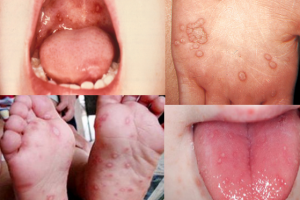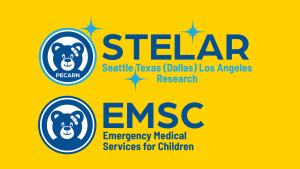Authors: Caleb Graham, MD (EM Resident Physician, UTSW/ Dallas, TX); Colin Danko, MD (EM Faculty Physician, UTSW/ Dallas, TX) // Reviewed by: Sophia Görgens, MD (EM Physician, BIDMC, MA); Cassandra Mackey, MD (Assistant Professor of Emergency Medicine, UMass Chan Medical School); Alex Koyfman, MD (@EMHighAK); Brit Long, MD (@long_brit)
Welcome to EM@3AM, an emDOCs series designed to foster your working knowledge by providing an expedited review of clinical basics. We’ll keep it short, while you keep that EM brain sharp.
A 37-year-old male comes in with facial trauma after his head slammed into the steering wheel during an MVC. He was able to walk away from the scene with no loss of consciousness, nausea, or vomiting. However, he has a headache that has become more painful. He was transported from the scene by EMS.
VS include BP 120/80, HR 99, T 98.2, RR 15, SpO2 99% on room air. After conducting a primary survey with no significant findings, you note significant ecchymosis and edema of the face. There is tenderness to the nose, and it appears to be displaced. Additionally, you notice clear drainage from the right naris.
Question: What is the likely diagnosis?
Answer: CSF Leak
Epidemiology:
- CSF leaks are broken into three main causes
- Craniofacial trauma: approximately 80% of cases1
- 3% of blunt head and 9% of penetrating head trauma patients have CSF leaks
- Basilar skull fractures commonly occur with CSF leaks (up to 30%)
- Iatrogenic: approximately 16% of cases1
- 3.8% of neurosurgical procedures have CSF leaks as a known complication2
- Pituitary tumor resection up to 50%3
- Can also occur with LPs, epidural anesthesia, other spinal procedures4
- Spontaneous: approximately 4% of cases1
- Predominately older patients and female patients5
- Craniofacial trauma: approximately 80% of cases1
Anatomy:
- CSF Leaks are broken into two main categories: cranial and spinal CSF leaks
- Cranial CSF leaks
- Occur when trauma or surgery causes a break between layers of mucosa, bone dura, and arachnoid space causing rhinorrhea6
- Spinal CSF leaks
- Three primary mechanisms: Meningeal diverticula, ventral dural tears, and CSF-venous fistulas
- Meningeal diverticula: Dura is weakened, causes meninges to form an outpouching that is prone to rupture7
- Ventral dural tears: Calcified disks or osteophytes cause a tear in the dura, leading to collecting of fluid in the epidural space8
- Venous fistula: Direct connection between the spinal subarachnoid space and paraspinal vein. Loss of CSF into the circulatory system is unregulated and cannot be reabsorbed, leading to intracranial hypotension.9
- Three primary mechanisms: Meningeal diverticula, ventral dural tears, and CSF-venous fistulas
- Cranial CSF leaks
Clinical Presentation:
- Cranial CSF leaks have the most common presentation of clear rhinorrhea with headache or neck pain
- CSF leaks typically occur with associated symptoms in the context of some inciting event, whether that is a surgical operation, an invasive procedure such as an LP, or trauma10
- Orthostatic headache (worsens with positional changes such as sitting/standing) is another common finding for both cranial and spinal CSF leaks10,11
- While physical exam is likely unremarkable, full neurological exam should be performed to adequately assess for other injuries in the case of recent instrumentation and primary/secondary surveys in the setting of trauma
Evaluation:
- Cranial CSF leak diagnosis
- Assessing clear discharge from nose or ear
- Sample clear discharge and look for CSF-specific proteins
- Beta-2 transferrin: not found in mucous or blood and highly sensitive/specific12
- Beta-trace protein: not found in mucous or blood and highly sensitive/specific13
- Do NOT assess for glucose as it can be a false positive
- Sample clear discharge and look for CSF-specific proteins
- Assessing bloody discharge from nose or ear
- Halo test: put discharge on paper towel and see if clear ring develops around blood
- Halo test is nonspecific as it can also be present with blood/saliva mixture
- Neuroimaging
- Required for formal diagnosis when rhinorrhea or otorrhea is not present
- Gold standard for diagnosis is high resolution CT or CT cisternography12
- MRI skull can be utilized as a second line modality
- Assessing clear discharge from nose or ear


- Spinal CSF Leak Diagnosis
- Clinical symptoms
- Orthostatic headache
- Lumbar puncture (not required but useful when no imaging available)
- Patient must be in the lateral decubitus position to measure LP opening pressure
- Low CSF pressure (pressure < 60mmHg)15
- Imaging
- CT Cisternography- often just as effective as MRI for evaluation of CSF leaks 15
- MRI Brain – evidence of brain sagging15,16
- MRI Spine – evidence CSF outside of the dura15,16
- Myelography – for localization of the leak (not required for diagnosis)
- Clinical symptoms


Treatment:
- Consult neurosurgery specialist
- Cranial CSF leak management
- Emergent evaluation and stabilization of patients in the setting of trauma
- Recognize who will need immediate neurosurgical evaluation, often CSF leaks PLUS:
- Open skull fractures
- Basilar skull fractures with bony defect
- Spontaneous CSF leaks10
- If stable and without one of the above pathologies, trial conservative management
- Raise the head of bed to reduce ICP
- Give analgesics for symptomatic management18
- No role for prophylactic antibiotics
- For spontaneous CSF leaks secondary to IIH, LPs may be indicated as part of management19
- If patients have still not improved, surgery may be indicated10
- Spinal CSF Leak Management
- Mild-moderate symptoms, less than 2 weeks
- Bed rest, epidural blood patch20
- Moderate-Severe symptoms, greater than 2 weeks
- Revaluate with imaging, possible surgical spine or IR intervention21
- Mild-moderate symptoms, less than 2 weeks
Disposition:
- In the case of traumatic injury, patient will require admission from a combination of their CSF leak in conjunction with other related injuries
- In the case of postsurgical CSF leaks, neurosurgery should be consulted for management and disposition
- In the case of spontaneous CSF leaks, patients should follow with neurosurgery outpatient for initial nonsurgical management (caffeine, blood patches, etc.).
Pearls:
- CSF leaks can be divided in two categories (cranial and spinal), each with different epidemiology, presentation, and management
- Cranial CSF Leaks require CT cisternography and may require surgical intervention with concerning features
- Spinal CSF Leaks may require MRI evaluation of head and spine for diagnosis but can often be managed conservatively initially
- Consultation of neurosurgery is indicated in all cranial CSF leaks

A 34-year-old man is brought to the ED following a motorcycle collision. He has significant facial trauma, and blood and serous fluid are leaking out of his left ear. His left face and eye have severe contusions. Which of the following tests is most accurate at determining if the patient has cerebrospinal fluid leakage?
A) Beta-2 transferrin test
B) Chloride test
C) Glucose test
D) Halo test
Answer: A
Cerebrospinal fluid (CSF) leaks occur when CSF escapes through a defect in the dura mater, the tough membrane surrounding the brain and spinal cord. Certain types of skull fractures can cause the dura mater to tear, creating communication between the subarachnoid space, the paranasal sinuses, and the middle ear. Basilar skull fractures, for example, can present with otorrhea or rhinorrhea within hours to days after injury and can sometimes be mistaken for a common runny nose or ear infection. The primary symptom is a persistent, positional headache that typically worsens when standing and improves when lying down. CSF leaks can also cause symptoms like neck stiffness, nausea, photophobia, tinnitus, and occasionally neurological deficits, particularly if there is significant pressure on surrounding brain structures.
Diagnosing a CSF leak requires a combination of clinical suspicion, patient history, and imaging studies. Patients with a sudden-onset headache after trauma or surgery or a history of connective tissue disorders are at higher risk for CSF leaks. Beta-2 transferrin testing of nasal or ear fluid is highly specific for CSF and can confirm the presence of a leak. Imaging studies are essential to locate the leak site. High-resolution CT or CT myelography may be needed for detail, particularly in spontaneous or low-pressure leaks.
Treatment of CSF leaks varies based on severity, location, and cause. Conservative management is often the first line of treatment and includes bed rest, increased hydration, caffeine intake, and medications like acetazolamide to reduce CSF production. When conservative measures fail, targeted epidural blood patches—typically used in spontaneous spinal CSF leaks—can help seal the defect. Surgical intervention is reserved for persistent leaks, often involving a repair of the dural tear through endoscopic, minimally invasive techniques. Timely management is essential to reduce the risk of complications, such as meningitis and chronic headaches, which may significantly impact a patient’s quality of life.

Although the concentration of chloride in the CSF is slightly higher than in plasma, measuring chloride (B) is not an accurate way to detect the presence of CSF.
Glucose testing (C) may be done rapidly but is unreliable for detecting CSF due to the abundance of false-positive results.
The halo test (D) is a less precise method of determining if CSF is present in the otorrhea or rhinorrhea of a head trauma patient. A drop of the fluid is placed on a tissue or filter paper, and a rapidly expanding ring (halo) of clear fluid around red blood defines a positive test. Other fluids, such as saline and saliva, can also result in a positive halo test.
FOAM Reading:
References:
- Ommaya AK, Di Chiro G, Baldwin M, Pennybacker JB. Non-traumatic cerebrospinal fluid rhinorrhoea. J Neurol Neurosurg Psychiatry. 1968 Jun;31(3):214-25.
- Coucke B, Van Gerven L, De Vleeschouwer S, Van Calenbergh F, van Loon J, Theys T. The incidence of postoperative cerebrospinal fluid leakage after elective cranial surgery: a systematic review. Neurosurg Rev. 2022 Jun;45(3):1827-1845. doi: 10.1007/s10143-021-01641-y. Epub 2021 Sep 9. Erratum in: Neurosurg Rev. 2022 Jun;45(3):2501. doi: 10.1007/s10143-022-01797-1. PMID: 34499261.
- Banks CA, Palmer JN, Chiu AG, O’Malley BW, Woodworth BA, Kennedy DW. Endoscopic closure of CSF rhinorrhea: 193 cases over 21 years. Otolaryngol Head Neck Surg. 2009 Jun;140(6):826-33
- Liao YJ, Dillon WP, Chin CT, McDermott MW, Horton JC. Intracranial hypotension caused by leakage of cerebrospinal fluid from the thecal sac after lumboperitoneal shunt placement. Case report. J Neurosurg. 2007 Jul;107(1):173-7. doi: 10.3171/JNS-07/07/0173. PMID: 17639890.
- Mamlouk MD, Shen PY, Jun P, Sedrak MF. Spontaneous Spinal CSF Leaks Stratified by Age, Body Mass Index, and Spinal Level. AJNR Am J Neuroradiol. 2022 Jul;43(7):1068-1072. doi: 10.3174/ajnr.A7548. Epub 2022 Jun 23. PMID: 35738670; PMCID: PMC9262061.
- Ramakrishnan N, Roy R, Singh S, Goyal S, Gupta DK, Chugh R. Approach to Management of Cerebrospinal Fluid Rhinorrhea: Institutional Based Protocol. Indian J Otolaryngol Head Neck Surg. 2022 Oct;74(Suppl 2):737-744.
- Enomoto N, Mure H, Okazaki T, Azumi M, Okita S, Nagahiro S, Takagi Y. Posttraumatic Cerebrospinal Fluid Leak Associated with an Upper Cervical Meningeal Diverticulum. World Neurosurg. 2018 Aug;116:50-55. doi: 10.1016/j.wneu.2018.05.061. Epub 2018 May 17. PMID: 29777885.
- Lee DH, Kim KT, Park JI, Park KS, Cho DC, Sung JK. Repair of Inaccessible Ventral Dural Defect in Thoracic Spine: Double Layered Duraplasty. Korean J Spine. 2016 Jun;13(2):87-90. doi: 10.14245/kjs.2016.13.2.87. Epub 2016 Jun 30. PMID: 27437022; PMCID: PMC4949176.
- Madhavan AA, Cutsforth-Gregory JK, Kumar N, Garza I, Whealy MA, Kissoon NR, Brinjikji W. CSF-venous fistulas associated with traumatic spinal pseudomeningoceles. Interv Neuroradiol. 2024 Aug 27:15910199241276575. doi: 10.1177/15910199241276575. Epub ahead of print. PMID: 39191383; PMCID: PMC11569719.
- Severson M, Schaurich CG, Strecker-McGraw MK. Cerebrospinal Fluid Leak. [Updated 2023 Mar 6]. In: StatPearls [Internet]. Treasure Island (FL): StatPearls Publishing; 2024 Jan-. Available from: https://www.ncbi.nlm.nih.gov/books/NBK538157/
- Mokri B, Hunter SF, Atkinson JL, Piepgras DG. Orthostatic headaches caused by CSF leak but with normal CSF pressures. Neurology. 1998 Sep;51(3):786-90. doi: 10.1212/wnl.51.3.786. PMID: 9748027.
- Le C, Strong EB, Luu Q. Management of Anterior Skull Base Cerebrospinal Fluid Leaks. J Neurol Surg B Skull Base. 2016 Oct;77(5):404-11. doi: 10.1055/s-0036-1584229. Epub 2016 Jun 2. PMID: 27648397; PMCID: PMC5023433.
- Tumani H, Nau R, Felgenhauer K. Beta-trace protein in cerebrospinal fluid: a blood-CSF barrier-related evaluation in neurological diseases. Ann Neurol. 1998 Dec;44(6):882-9. doi: 10.1002/ana.410440606. PMID: 9851432.
- Ibrahim D, CSF rhinorrhea – CT cisternography. Case study, Radiopaedia.org (Accessed on 17 Nov 2024) https://doi.org/10.53347/rID-31342
- Kranz PG, Gray L, Malinzak MD, Amrhein TJ. Spontaneous Intracranial Hypotension: Pathogenesis, Diagnosis, and Treatment. Neuroimaging Clin N Am. 2019 Nov;29(4):581-594. doi: 10.1016/j.nic.2019.07.006. Epub 2019 Aug 26. PMID: 31677732.
- Amrhein TJ, Kranz PG. Spontaneous Intracranial Hypotension: Imaging in Diagnosis and Treatment. Radiol Clin North Am. 2019 Mar;57(2):439-451. doi: 10.1016/j.rcl.2018.10.004. Epub 2018 Dec 7. PMID: 30709479.
- Dughly M, Spinal epidural CSF leak. Case study, Radiopaedia.org (Accessed on 02 Dec 2024) https://doi.org/10.53347/rID-157321
- Phang SY, Whitehouse K, Lee L, Khalil H, McArdle P, Whitfield PC. Management of CSF leak in base of skull fractures in adults. Br J Neurosurg. 2016 Dec;30(6):596-604. doi: 10.1080/02688697.2016.1229746. Epub 2016 Sep 26. PMID: 27666293.
- Yilmazlar S, Arslan E, Kocaeli H, Dogan S, Aksoy K, Korfali E, Doygun M. Cerebrospinal fluid leakage complicating skull base fractures: analysis of 81 cases. Neurosurg Rev. 2006 Jan;29(1):64-71. doi: 10.1007/s10143-005-0396-3. Epub 2005 Jun 4. PMID: 15937689.
- Amoozegar F, Guglielmin D, Hu W, Chan D, Becker WJ. Spontaneous intracranial hypotension: recommendations for management. Can J Neurol Sci. 2013 Mar;40(2):144-57. doi: 10.1017/s0317167100013664. PMID: 23419561.
- Callen AL, Timpone VM, Schwertner A, Zander D, Grassia F, Lennarson P, Seinfeld J, Lillehei KO, Birlea M, Thaker AA. Algorithmic Multimodality Approach to Diagnosis and Treatment of Spinal CSF Leak and Venous Fistula in Patients With Spontaneous Intracranial Hypotension. AJR Am J Roentgenol. 2022 Aug;219(2):292-301. doi: 10.2214/AJR.22.27485. Epub 2022 Mar 9. PMID: 35261281.








